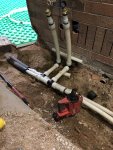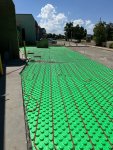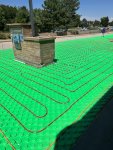Car Wash Forum
You are using an out of date browser. It may not display this or other websites correctly.
You should upgrade or use an alternative browser.
You should upgrade or use an alternative browser.
Another tankless water heater replacing boiler thread
- Thread starter OurTown
- Start date
OurTown
Well-known member
2Biz
Thread Killer!
That boiler is a lot less restrictive than my Takagi...@ 35° Delta it has a flow rate of 24gpm and 2.2ft of head pressure. I operate mine a little higher delta than that. From 55° to 105°, so about 60° delta down to about 45° delta. The manual also says you can supply pressure to the boiler using a single 0010 or 013 taco...I think I would question the manufacturer since they surely know a lot more than when I installed my heater! LOL...Now they advertise most of them for hydronic heating! The only other consideration, is you can't or are not allowed to do an install or service a boiler this size. Anything below 200k and you are allowed by code. Thats why you see heaters/boilers rated at 199k! They are just under the code requiring a licensed tech....$8k is pricey but you are getting a lot more than what I installed! Although, if all it cost me was a second pump to get the pressure needed, then its all in how you look at it! Mine works fine! You will have some decisions to make! LOL


OurTown
Well-known member
Back to the drawing board on this as he said the install would be in the upper 20 something thousand. He is willing to install two tankless water heaters but needs someone else to design the system. He said the price would not exceed $9K depending on the units and pumps. Normally I would take on this project myself but we are going to have building inspectors in and out during this massive remodel. 
OurTown
Well-known member
Also I need to design the tubing layout for two aprons. We are wanting to reuse the 1/2" 10 outlet manifold to keep it balanced with the self serve side. Is 190 feet the max run for 1/2"? Can we cheat the length a bit by insulating them until they get to the aprons? One apron is going to be about 65 feet from the manifold to the slab. That eats up 130 feet per run right there.
2Biz
Thread Killer!
What does the building inspectors have to do with a floor heat upgrade? If you stay under 199k for each heater, you can do it yourself. No boiler liscence needed....Or will it need to be inspected regardless of who does the work? I don't have to deal with any of that where I'm located. Maybe you can contact the inspectors to see what is required, first step? BTW, 20 "Something" thousand seems rediculous! I did my single heater and pumps for under $2500. And the Takagi's are now cheaper than when I did my install...$1200 and some change each!Back to the drawing board on this as he said the install would be in the upper 20 something thousand. He is willing to install two tankless water heaters but needs someone else to design the system. He said the price would not exceed $9K depending on the units and pumps. Normally I would take on this project myself but we are going to have building inspectors in and out during this massive remodel.
2Biz
Thread Killer!
I don't think "Cheating" the length to get heat to the area is what you need to be concerned with....It has to do with the size tubing you use creates its own head pressure depending on length. The longer the length, the more pressure you need to force the glycol through the lines. Larger lines require less pressure, smaller size pump/pumps...I'm sure you can find a head pressure calculator online to help give you the answers....You don't want to "Guess" at it!Also I need to design the tubing layout for two aprons. We are wanting to reuse the 1/2" 10 outlet manifold to keep it balanced with the self serve side. Is 190 feet the max run for 1/2"? Can we cheat the length a bit by insulating them until they get to the aprons? One apron is going to be about 65 feet from the manifold to the slab. That eats up 130 feet per run right there.
OurTown
Well-known member
What does the building inspectors have to do with a floor heat upgrade? If you stay under 199k for each heater, you can do it yourself. No boiler liscence needed....Or will it need to be inspected regardless of who does the work? I don't have to deal with any of that where I'm located. Maybe you can contact the inspectors to see what is required, first step? BTW, 20 "Something" thousand seems rediculous! I did my single heater and pumps for under $2500. And the Takagi's are now cheaper than when I did my install...$1200 and some change each!
Maybe it doesn't need inspected because it is a closed loop system and not connected to the city water supply. There would be gas lines moved and thought they had to inspect those. I'll call and ask. The big money price is for a boiler replacement but he thinks a double tankless install should be under $9K depending on the units and pumps.
OurTown
Well-known member
I don't think "Cheating" the length to get heat to the area is what you need to be concerned with....It has to do with the size tubing you use creates its own head pressure depending on length. The longer the length, the more pressure you need to force the glycol through the lines. Larger lines require less pressure, smaller size pump/pumps...I'm sure you can find a head pressure calculator online to help give you the answers....You don't want to "Guess" at it!
From what I understand in order to keep the system balanced and return temps similar to each other the run lengths should be the same. I'm not sure about the head pressures. On another note I'm told I will have zero warranty on Rinnai tankless units used on floor heat.
2Biz
Thread Killer!
You balance the zones by using the ball valves on the manifold. My furthest bay I have the ball valve wide open...You throttle the rest of the zones so each zone slab temps are as close to 40° as possible. Head pressure for all zones will be different, so the zone with the least length will get the most flow (least head pressure), robbing from the longer zones. Basically when throttling each of the shorter length zones, you are balancing flow to be the same as the longest length zone. In essence the same thing as keeping the return temps all the same. My trough heat zone is wide open, but it looses very little heat. So really not part of the equation. In a CW setting, there is no way to keep all the zone lengths the same!
Does it have to be a Rinnai? I don't think all manufacturers are like that? Mine isn't....Even if it wasn't covered...The heater is only $1200. Its not like its $10K. I'm going on 11 years now and still running perfectly...Knock on wood! LOL
Does it have to be a Rinnai? I don't think all manufacturers are like that? Mine isn't....Even if it wasn't covered...The heater is only $1200. Its not like its $10K. I'm going on 11 years now and still running perfectly...Knock on wood! LOL
2Biz
Thread Killer!
Looking at the photo, the BV at the left is the truck bay (bay 4) which is 3 bays from the ER. The BV is wide open. Bay 3 is closed just a little more than bay 4. Bays 3 and 4 are on either side of the ER, so the BV's are closed even more and positioned the same since they are the same distance and line length from the ER... Correction on the 5th zone trough heat, looks like I have it closed down even more than the rest of the zones, but regardless, it gives up the least amount of heat, so it requires very little flow. Once I set the flow rates, I haven't changed them since installation 11 years ago.

cantbreak80
Maybe I need new clubs
I’ve always used 200’ maximum length of loops – with a 10% variable. This eliminates the need for “balancing valves”
But, running all loops to and from the equipment room makes that design quite difficult.
Our solution is to install manifolds for every 2 bays…at the entrance or exit apron. We’ve even done manifolds on both sides of the bays; supply on one side, return on the other.
Our latest 6 bay installation features 4 manifold boxes. All piping from the equipment room is 1-1/2” PEX. The manifolds live in boxes set to finished floor height. With entry-side concrete heated to the building’s winter shadow line, these loops are approximately 165’ each (+ or - 16’).

And, another 3 loops per bay with ~165' loop installation in progress. The IR photo shows how effective the insulation is during "polar vortex" conditions. (-2 degrees).



Good measurements and planning are necessary to draw the map. I've spent many hours just refining layout drawings.
But, running all loops to and from the equipment room makes that design quite difficult.
Our solution is to install manifolds for every 2 bays…at the entrance or exit apron. We’ve even done manifolds on both sides of the bays; supply on one side, return on the other.
Our latest 6 bay installation features 4 manifold boxes. All piping from the equipment room is 1-1/2” PEX. The manifolds live in boxes set to finished floor height. With entry-side concrete heated to the building’s winter shadow line, these loops are approximately 165’ each (+ or - 16’).

And, another 3 loops per bay with ~165' loop installation in progress. The IR photo shows how effective the insulation is during "polar vortex" conditions. (-2 degrees).



Good measurements and planning are necessary to draw the map. I've spent many hours just refining layout drawings.
OurTown
Well-known member
I’ve always used 200’ maximum length of loops – with a 10% variable. This eliminates the need for “balancing valves”
But, running all loops to and from the equipment room makes that design quite difficult.
Our solution is to install manifolds for every 2 bays…at the entrance or exit apron. We’ve even done manifolds on both sides of the bays; supply on one side, return on the other.
Our latest 6 bay installation features 4 manifold boxes. All piping from the equipment room is 1-1/2” PEX. The manifolds live in boxes set to finished floor height. With entry-side concrete heated to the building’s winter shadow line, these loops are approximately 165’ each (+ or - 16’).
View attachment 10042
And, another 3 loops per bay with ~165' loop installation in progress. The IR photo shows how effective the insulation is during "polar vortex" conditions. (-2 degrees).
View attachment 10044 View attachment 10045 View attachment 10046
Good measurements and planning are necessary to draw the map. I've spent many hours just refining layout drawings.
On my first attempt to draw the entrance apron I have three loops with the longest being 139' and the shortest at 99'. The exit apron is really far away from the manifolds so I'm thinking I'll try to make the entrance apron two loops for better balancing. This is going to take time to draw this up and keep all run lengths within 10%.
2Biz
Thread Killer!
CantBreak80, Your solution makes perfect sense on a new install. Although, there are not too many new installs on this forum. Most posts are updates to the OLD OLD warn out boilers where owners choose to use the tubing that is already in place. So balancing valves are required...Just making sure everyone distinguishes between the two!
cantbreak80
Maybe I need new clubs
No disagreement there, 2Biz.
I think I read that OurTown is doing a tear-out...so, my post is intended to provide some revisionist theory and concepts.
BTW...We recently completed the 4th tear-out and re-pour in 2 years. (Man, I am way too old for these projects.)
OurTown,
Welcome to the world of hydronics!
Imagine how long it took us to design this layout with all it's zigs, zags and obstacles!


I think I read that OurTown is doing a tear-out...so, my post is intended to provide some revisionist theory and concepts.
BTW...We recently completed the 4th tear-out and re-pour in 2 years. (Man, I am way too old for these projects.)
OurTown,
Welcome to the world of hydronics!
Imagine how long it took us to design this layout with all it's zigs, zags and obstacles!


OurTown
Well-known member
I have my tubing layout design finished and I'm fairly happy with it. Two runs to the entrance that will be on the North side in winter. One will be about 172 ft and the other will be about 173 ft. On the exit apron facing South there will be five runs with the shortest at about 182 ft and the longest at about 195 ft. On those runs they will go under a 3' wide by about 60' sidewalk next to the new building on their way to and back to the apron so I'm thinking we should insulate the runs going out and not insulate them coming back. My thought is that it may help balance the system a bit and even with the insulation there will be way more heat in the sidewalk than we need. I'm sure it will be steaming.
OurTown
Well-known member
Most of the tankless water heaters do not have a warranty for this application. Most state they should not run alcohol through them or be in a closed loop system. Most of the Takagi models would still have a warranty though and they do not make any actual boilers which I find those two things together interesting. It is as if the other brands that make both want to push hydronic heating away from their water heaters to installing their boilers. One thing my plumber brought up a while back was the Ruud boilers at Menards. I looked at them but the biggest one is only 199K which would be too small for our total usage. Now I'm thinking why not use two of those? They are very low cost for an actual boiler and my plumber said there's a Ruud rep that he has support from which is nice. His main distributor steers him to their much more expensive boilers and gets no support for installing the tankless water heaters on hydronic systems. They are larger than tankless units but they are not huge. We could use a 199K for the old side with the three self serve bays and their aprons (10 runs buried under 7" of concrete) and a 180K unit for the new side . (7 runs installed correctly plus the trough run)
https://www.menards.com/main/plumbi...oiler/rucbh199dvln/p-1567578506367-c-8519.htm
https://www.menards.com/main/plumbi...oiler/rucbh199dvln/p-1567578506367-c-8519.htm
2Biz
Thread Killer!
Interesting.....The Ruud is classified as a boiler, but will only put out 4.5 gpm at 77° rise...My takagi puts out 6 gpm at 50° rise....(from 55°-70° temp return from the bays to 105° heater setpoint temp. Not much difference... Also note the Ruud is listed as a combi boiler...You sure this is what you want? Heating mode looks to be only 120K BTU...


OurTown
Well-known member
Also note the Ruud is listed as a combi boiler...You sure this is what you want? Heating mode looks to be only 120K BTU...
That is odd and something I missed. Probably not going to work. There's always something.
2Biz
Thread Killer!
Sorry to be the "Debbie Downer"!That is odd and something I missed. Probably not going to work. There's always something.





